Submarine fault scarps in the Sea of Marmara pull-apart ... - HAL - IRD
Submarine fault scarps in the Sea of Marmara pull-apart ... - HAL - IRD
Submarine fault scarps in the Sea of Marmara pull-apart ... - HAL - IRD
You also want an ePaper? Increase the reach of your titles
YUMPU automatically turns print PDFs into web optimized ePapers that Google loves.
Geochemistry<br />
Geophysics<br />
Geosystems G 3<br />
G 3 armijo et al.: sea <strong>of</strong> marmara <strong>pull</strong>-<strong>apart</strong> 10.1029/2004GC000896<br />
(Figure 9b). To be consistent with both <strong>the</strong> exposed<br />
free face and <strong>the</strong> slickensides, a net oblique slip <strong>of</strong><br />
4–6 m is required for <strong>the</strong> last <strong>fault</strong><strong>in</strong>g <strong>in</strong>crement<br />
and about twice this amount to expla<strong>in</strong> <strong>the</strong> total<br />
vertical <strong>of</strong>fset <strong>of</strong> <strong>the</strong> flat surface.<br />
[32] Conspicuous zones <strong>of</strong> cold fluid and methane<br />
seepage with associated bacterial mats, authigenic<br />
carbonate crusts and symbiotic life were discovered<br />
with <strong>the</strong> ROV <strong>in</strong> close spatial association with<br />
<strong>the</strong> submar<strong>in</strong>e <strong>fault</strong> <strong>scarps</strong>, suggest<strong>in</strong>g that <strong>the</strong><br />
active <strong>fault</strong> zones control <strong>the</strong> fluid circulation<br />
with<strong>in</strong> <strong>the</strong> sedimentary pile. A full description <strong>of</strong><br />
<strong>the</strong>se features is beyond <strong>the</strong> scope <strong>of</strong> this paper, but<br />
we show here a spectacular example <strong>of</strong> an active<br />
vent and associated features <strong>in</strong> <strong>the</strong> SE Tekirdag<br />
Bas<strong>in</strong>, along <strong>the</strong> same set <strong>of</strong> small-scale <strong>scarps</strong><br />
(Figure 9c; location <strong>in</strong> Figure 8).<br />
[33] Vents and carbonate crusts appear broken and<br />
<strong>of</strong>fset by <strong>the</strong> most recent scarp reactivations, <strong>of</strong>fer<strong>in</strong>g<br />
stratigraphic evidence useful for identify<strong>in</strong>g<br />
discrete events. Such a case is visible <strong>in</strong> Figure 9d,<br />
where a young flat carbonate slab appears deposited<br />
at <strong>the</strong> base <strong>of</strong> an older scarp (which is<br />
locally very well preserved), but <strong>the</strong> carbonate slab<br />
itself is ruptured parallel to <strong>the</strong> scarp by <strong>the</strong> last<br />
scarp-enlarg<strong>in</strong>g event, provid<strong>in</strong>g ‘‘field’’ evidence<br />
for a penultimate event which could be <strong>of</strong> similar<br />
size as <strong>the</strong> last event. Thus converg<strong>in</strong>g evidence<br />
(microbathymetry and ‘‘field’’ observations) <strong>in</strong>volve<br />
<strong>the</strong> occurrence <strong>of</strong> successive earthquake<br />
ruptures <strong>of</strong> similar size on <strong>the</strong> SE Tekirdag <strong>fault</strong>.<br />
The ruptures are young, but <strong>the</strong> last one ( 5m<strong>of</strong><br />
right-lateral slip) that is preserved with its <strong>in</strong>tact<br />
t<strong>in</strong>y features must be particularly recent.<br />
3.6. Thrust Scarps <strong>in</strong> <strong>the</strong> Southwestern<br />
Tekirdag Bas<strong>in</strong> at <strong>the</strong> Ganos Fault Bend<br />
[34] The bend where <strong>the</strong> sou<strong>the</strong>rn Tekirdag <strong>fault</strong><br />
system veers southwestward to meet <strong>the</strong> Ganos<br />
<strong>fault</strong> is a long-lived restra<strong>in</strong><strong>in</strong>g bend (Figure 1).<br />
S<strong>in</strong>ce <strong>the</strong> NAF has propagated westward across <strong>the</strong><br />
Ganos-Dardanelles region (at circa 5 Ma), a series<br />
<strong>of</strong> folds <strong>in</strong>volv<strong>in</strong>g neogene sediments have formed<br />
successively at <strong>the</strong> Ganos bend, <strong>the</strong>n transported<br />
southwestward alongside <strong>the</strong> NAF (Ganos <strong>fault</strong>) by<br />
its cont<strong>in</strong>u<strong>in</strong>g right-lateral motion [see Armijo et<br />
al., 1999, Figure 3]. A discussion <strong>of</strong> <strong>the</strong> contemporary<br />
<strong>fault</strong> geometry and k<strong>in</strong>ematics, <strong>in</strong>clud<strong>in</strong>g<br />
details around <strong>the</strong> Ganos bend, is given by Armijo<br />
et al. [2002] (see <strong>the</strong>ir Figure 5).<br />
[35] The geometry <strong>of</strong> <strong>scarps</strong> at <strong>the</strong> submar<strong>in</strong>e <strong>fault</strong><br />
bend <strong>in</strong> <strong>the</strong> southwestern Tekirdag Bas<strong>in</strong> is illustrated<br />
<strong>in</strong> (Figures 10a and 10b). Fault segments<br />
about 500–800 m long and strik<strong>in</strong>g NE on <strong>the</strong><br />
average are disposed <strong>in</strong> a regular right-stepp<strong>in</strong>g en<br />
echelon array. Here aga<strong>in</strong> one can check <strong>the</strong> oneto-one<br />
correspondence between scarp features seen<br />
<strong>in</strong> <strong>the</strong> microbathymetry and <strong>in</strong> <strong>the</strong> side-scan sonar<br />
images (Figures 10a and 10b). This can be made <strong>in</strong><br />
spite <strong>of</strong> <strong>the</strong> somewhat less precise position<strong>in</strong>g <strong>of</strong><br />
<strong>the</strong> side-scan strip. The NE-strik<strong>in</strong>g, right-stepp<strong>in</strong>g<br />
en echelon structure associated with transpression<br />
here can be compared with <strong>the</strong> NW-strik<strong>in</strong>g, leftstepp<strong>in</strong>g<br />
en echelon structure <strong>of</strong> <strong>scarps</strong> <strong>in</strong> <strong>the</strong><br />
sou<strong>the</strong>rn Central Bas<strong>in</strong> associated with transtension<br />
(see Figures 10a, 10b, 2, 4a, and 4b). The contrast<br />
is mean<strong>in</strong>gful, provid<strong>in</strong>g support to <strong>the</strong> <strong>in</strong>ference <strong>of</strong><br />
a component <strong>of</strong> NW-SE shorten<strong>in</strong>g expressed by<br />
northwestward directed thrust<strong>in</strong>g as <strong>the</strong> south<br />
Tekirdag <strong>fault</strong> veers <strong>in</strong>to <strong>the</strong> Ganos retra<strong>in</strong><strong>in</strong>g bend.<br />
[36] Once more small-scale <strong>in</strong>dividual <strong>scarps</strong> tear<strong>in</strong>g<br />
a larger cumulative scarp are identified (see s1,<br />
s2 <strong>in</strong> <strong>the</strong> side-scan enlargement). In some places<br />
<strong>the</strong> en echelon structure yields multiple <strong>scarps</strong> <strong>in</strong><br />
cross section (pr<strong>of</strong>ile 1, Figure 10c). In o<strong>the</strong>r places<br />
only one <strong>fault</strong> scarp (s1) accumulates slip over <strong>the</strong><br />
long-term (pr<strong>of</strong>ile 2, Figure 10c).<br />
[37] Pr<strong>of</strong>ile 1 demonstrates that <strong>the</strong> <strong>in</strong>dividual<br />
<strong>scarps</strong> seen <strong>in</strong> <strong>the</strong> sonar imagery are associated<br />
with larger <strong>scarps</strong> with convex shape. That convexity<br />
is strongly suggestive <strong>of</strong> near seafloor upwarp<strong>in</strong>g<br />
<strong>of</strong> <strong>the</strong> lead<strong>in</strong>g edges <strong>of</strong> <strong>the</strong> thrust hang<strong>in</strong>g<br />
walls. Those features are typical <strong>of</strong> active thrust<br />
<strong>scarps</strong> seen on land [e.g., Bilham and Yu, 2000]. It<br />
is <strong>in</strong>terest<strong>in</strong>g to compare microbathymetry pr<strong>of</strong>iles<br />
<strong>of</strong> en echelon <strong>scarps</strong> at <strong>the</strong> same scale, here<br />
for <strong>scarps</strong> with thrust component (pr<strong>of</strong>ile 1 <strong>in</strong><br />
Figure 10c) and <strong>in</strong> <strong>the</strong> Central Bas<strong>in</strong> for <strong>scarps</strong><br />
with normal <strong>fault</strong> component (Figure 4c). The<br />
stepped morphology <strong>of</strong> normal <strong>fault</strong> <strong>scarps</strong> has<br />
been replaced by rounded thrust up-warps. However,<br />
while <strong>the</strong> f<strong>in</strong>e-scale features <strong>of</strong> <strong>in</strong>dividual<br />
Figure 8. Morphology <strong>of</strong> comb<strong>in</strong>ed strike- and normal-slip <strong>scarps</strong> <strong>in</strong> <strong>the</strong> sou<strong>the</strong>astern Tekirdag Bas<strong>in</strong>. (a) Oblique<br />
3-D microbathymetry view <strong>of</strong> 10-m-high cumulative scarp and smaller <strong>in</strong>dividual break that is very l<strong>in</strong>ear and<br />
cont<strong>in</strong>uous over <strong>the</strong> sea bottom. Contours every 0.5 m. Small red crosses locate detailed pr<strong>of</strong>ile. Red arrows <strong>in</strong>dicate<br />
<strong>fault</strong> trace. (b) Enlarged pr<strong>of</strong>ile across <strong>in</strong>dividual scarp with nearly vertical free face 1–1.5 m high. No vertical<br />
exaggeration. Dashed l<strong>in</strong>e suggests cumulative <strong>of</strong>fset <strong>of</strong> <strong>in</strong>itially flat bottom surface, possibly result<strong>in</strong>g from last two<br />
events. Location <strong>of</strong> active vent ‘‘Jack <strong>the</strong> smoker’’ is <strong>in</strong>dicated.<br />
18 <strong>of</strong> 29




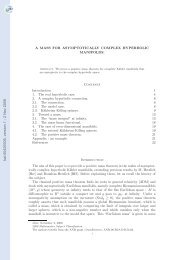

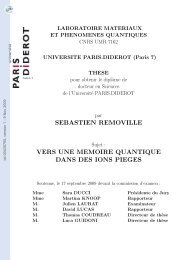
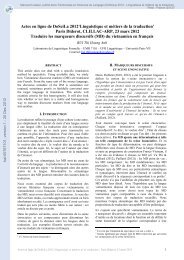
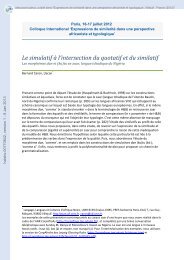
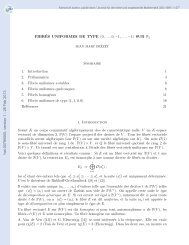
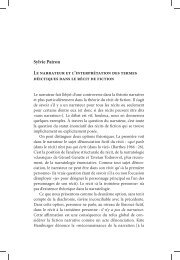
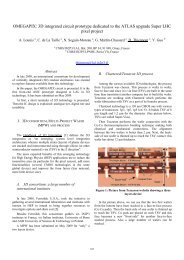
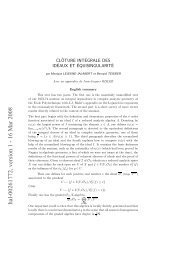
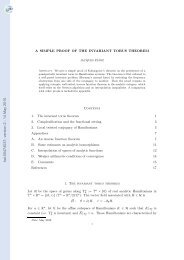

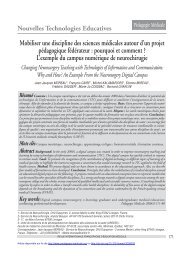

![[tel-00433556, v1] Relation entre Stress Oxydant et Homéostasie ...](https://img.yumpu.com/19233319/1/184x260/tel-00433556-v1-relation-entre-stress-oxydant-et-homeostasie-.jpg?quality=85)